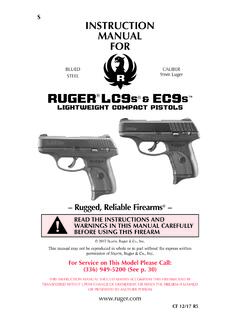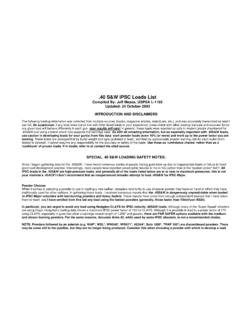Transcription of USPSA Competition Rules - MCARBO
1 USPSA Competition Rules March 2020 Copyright 2020 by USPSA /IPSC, Inc. Burlington, WA 98233 USPSA Competition Rules March 2020 2 Permission to Print Rulebook This rulebook may be printed for personal use. A copyright permission letter can be found at: USPSA Competition Rules March 2020 3 PRINCIPLES of USPSA Competition 1. Practical Competition is open to all reputable persons without regard to occupation. It may specifically NOT be limited to public servants. 2. Accuracy, power and speed are the equivalent elements of practical shooting and practical Competition must be conducted in such a way as to evaluate these elements equally.
2 3. Firearm types are not separated within their respective divisions; all compete together without handicap. This does not apply to the power of the firearms as power is an element to be recognized and rewarded. 4. Practical shooting Competition is a test of expertise in the use of practical firearms and equipment. 5. Practical Competition is conducted using practical targets, which reflect the general size and shape of such objects as the firearm used may reasonably be called upon to hit in their primary intended use.
3 6. The challenge presented in practical Competition must be done with the utmost safety in mind. Courses of Fire should follow a practical rationale and simulate hypothetical situations in which firearms might reasonably be used. 7. Practical Competition is diverse, never permitting unrealistic specialization of either technique or equipment. Problems are constantly changed. The exception is Classifier Stages which are used to measure practical shooting skill. 8. Practical Competition is freestyle.
4 In essence, the competitive problem is posed in general and the participant is permitted the freedom to solve it in the manner he considers best within the limitations of the competitive situation as provided. USPSA Competition Rules March 2020 4 The USPSA Classification System Grand Master 95 to 100% Master 85 to A Class 75 to B Class 60 to C Class 40 to D Class Below 40% Your percentage is based on your scores as they relate the average high scores on file for a particular course of fire.
5 To receive an initial classification, a member needs to have at least four unduplicated scores in the USPSA classification database. If there are more than four scores on file, the best four scores of the most recent six scores will be used. Scores are sorted according to the match date to determine which scores are the most recent. For matches that are Level I Specials, the scores are further sorted by the score percent in descending order. In doing so, the lowest scores from a special will be the first scores to drop out of the most recent scores on file.
6 After a member has earned a classification, the classification system will look at the best six unduplicated scores of the most recent eight to evaluate the member s current classification percentage. No scores that calculate to less than 2 percent are used. Also, to prevent unusually low scores from affecting your classification percentage, scores that are more than 5 percent below your classification bracket ( a score of for a C-class competitor) are not used for classification purposes. To guard against the possibility of incorrect stage setup or typographical error, scores that are more than 20 percent above your current classification bracket are evaluated at the time of entry to see if such a score would adversely affect your classification.
7 In general, those scores are entered, but occasionally a score is so out of the ordinary it is not used and flagged with an A. So that members can keep track of their scores, all scores received are entered into the database, but may be given a flag to indicate its status. The possible flags are: A A score that is more than 20% above the member s current classification bracket. B A score that is more than 5% below the member s current classification bracket or a score less than 2%. C A score that is more than one class below the highest class in any division attained by the member.
8 A member has a Master class in Open division and a B class score in Limited is submitted. This score will be flagged with C and not used. D Duplicate course - a higher score for this course already exists in the most recent six or eight scores. E A score that is not in the most recent six or eight scores. F A score that is one of the two lowest scores in the most recent six or eight scores. Y A score that has been used as part of the classification percentage calculation. USPSA Competition Rules March 2020 5 Please note that for unclassified members, the first scores submitted, except for those that are 2 percent or less, will be used to calculate an initial classification.
9 After a classification has been earned in a division, new scores will be evaluated according to the flagging system shown above. This can and does result in new scores not being used for reclassification purposes even though they are higher than some of the initial scores that were submitted, but still lower than your classification bracket. Any such low score should move out of the most recent group as newer scores that conform to your current classification are entered into the system. The classification system is run weekly, usually on Tuesday night, but may run at other times, as not to affect classifications during major matches.
10 If you feel your classification is too low, you may request the next higher class, up to but not including Grand Master. Requests are made in writing and submitted with a letter from your club president or Section Coordinator (SC) endorsing your request. If your request is approved, you will be moved up at the next regular calculation period. Your performance in larger matches and tournaments may also be used to help establish classification. Your percentage in a Level II or III match will be used as a classifier if there are more than 50 competitors in your division, and 3 Grand Masters placing at 90% or above.






